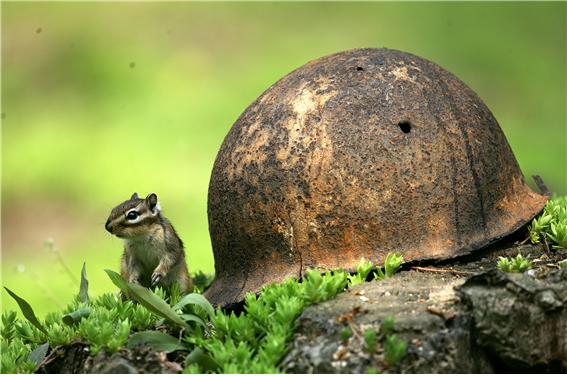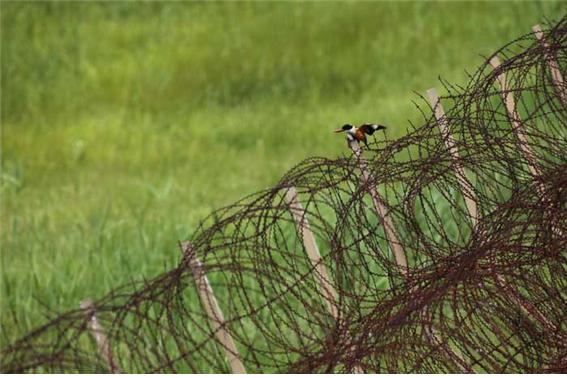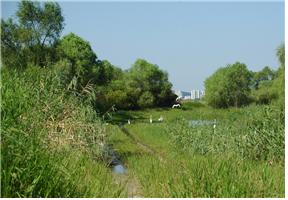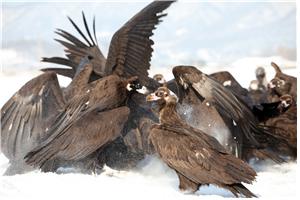Ecological Characteristics
Despite the continual pain, The overflowing bounty of Nature
从未有一句抱怨,不断培养珍贵生命的宽容的大自然
How long the burned-out has fields taken to regenerate itself? Furthermore, how long has an animal taken to come back to the green fields? I want to extend my cordial and grateful regards to Nature that became a home for precious creatures again.
烧焦的平原多久才能恢复到往日的葱绿?同时,又需要多久才能牛羊遍地、动物成群?
我想再次对这些生命的乐园,对抚育这些宝贵生命的土地,说一声抱歉,同时也说一声感谢。

<A Squirrel Next to a Rusty Military Cap> Photo by Jun Young-jae
<锈迹斑斑的钢盔旁的松鼠>照片——Jeon Youngjae
What we know or what we do not know about the DMZ ecosystem
对于DMZ生态系统,我们知道的和不知道的
We should not miss one thing when talking about the DMZ. It is just ‘a repository of the ecosystem preserved the unspoilt natural environment’. Through various newspaper articles and TV broadcasts, we have seen migratory birds flying across the DMZ and fishes swimming in the crystal-clear water. It is impressive to see a deer and an elk running around the fields, and a goat standing on a cliff. We cannot help but admire the greatness of nature to create a new life, even though it was the war-torn land in the past. But is all this really true?
提起DMZ(非武装地带),有一件事情我们绝不会遗漏。就是“没有人类干涉,自然环境保存完好的生态系统宝库”。
通过各种报纸新闻和电视节目,我们看到了飞过DMZ地区的鸟、在清澈的溪水中自由穿梭的鱼。我们感动于在原野上成群结队飞奔而过的狍子河鹿、
以及在悬崖上笔直站立的山羊。即使是在被战争破坏成一片废墟的土地上,生命依然在顽强生长,我们不得不感叹大自然的伟大。但是,这一切都是真的吗?
In fact, it is difficult to say that the DMZ is ‘a preserved place as the unspoilt natural environment which has been untouched’. It had been the furious battlefield during the Korean War. The front line had been around the DMZ during two-thirds of the war period. The habitat of many wild animals were destroyed as many houses and cropland were around there. An army had been trying to capture an enemy’s fortress on a hill, so plants in a forest were destroyed by fire. After the end of the war, the movement of animals along the mountain range was blocked by the ceasefire line across the east-west. Seeds of the plant moving to attach to the animal body could not spread further. In other words, the DMZ may be regard as the war-weary place by severe interference as well as military operations, not just the unspoilt natural environment which has been untouched.
事实上,“DMZ是一个没有人类干涉,自然环境保存完好的地方”这种说法很牵强。6.25战争期间,DMZ地区的战役一个接一个。战争期间2/3的战役都是在DMZ地区进行。就如同被破坏的这里居民的家园和农田一样,许多动物的栖息地也被破坏了。
随着抢夺高地的“高地战“的打响,森林里的植物也都被火烧光了。战争结束时所设的横跨东西的停火线,也切断了沿山脉迁徙的动物迁移路线。
依附在动物身上进行迁移的植物种子也不能进一步扩散了。换句话说,DMZ并不是一个没有人类干涉的,自然环境保存完好的地方,而是一个被残酷的战争严重破坏,停战后又被各种军事作战严重破坏的地方。

<Halcyon Pileata on the Southern Boundary Line> Photo by Jun Young-jae
<南部边界线停火线旁的鹦鹉>照片——Jeon Youngjae
If the DMZ ecosystem were different from what we know, where is the ‘nature of the DMZ’ that we have seen until now? It is mostly about the restricted civilian area. The absence of clear demarcation between the DMZ and the restricted civilian area created this problem. It is sure that the DMZ and the restricted civilian area affect each other because they are contiguous. However, the main ecological areas of the restricted civilian area, such as the Cheorwon plain, Yongneup swamp of Mt. Daeamsan and Dutayeon Valley, should not be presented as nature of the DMZ.
如果DMZ生态系统并不是我们所知道那样,那我们这段时间一直看到的“DMZ的自然”又从何说起呢?
他们都是普通民众无法进入的管制区域。其实是没有明确区分“DMZ和平民管制区域”的范围,或者将两者混淆了才引起了上述问题。当然DMZ和平民管制区域位置上是连接在一起的,因此可能会互相影响。但是将铁原平原、大岩山龙沼和头陀渊等平民管制区域内的主要生态区称作“DMZ地区的自然”来介绍是不应该的。
The unique ecosystem with a variety of species
多种物种聚集形成的独特生态系统
The DMZ and the restricted civilian area are the rigorous military zone as well as the east-west ecological axis of the Korean peninsula that various wildlife, including endangered species, inhabits. Since the Korean War, these areas have been influenced by continuous military operations and activities, and restricted to the public, so they became shelters for wildlife. It seems to go through the very unique restoration process. Therefore, the question should be premised: “The ecosystem was devastated by the Korean War, but 60 years later, now, what does it look like?”
DMZ和平民管制区都是严格的军事区域,同时也是许多面临灭种危机的野生动植物栖息的韩半岛东西生态轴,因此备受关注。6.25战争结束后,受到不断的军事作战和活动的影响,该地区限制向普通民众开放,原本是野生动植物避难所的此地区,经历了一个艰难的生态系统复原的过程。因此,为了准确把握DMZ地区的生态系统的现状,我们不得不提出这样一个疑问“6.25战争结束60年后的今天,因战争而完全破坏的生态系统现在是个什么样子呢?”
Forest fires periodically occur due to the military purpose or the natural reason around DMZ. Fires damage a forest. On the other hand, it accelerates the growth of a herbaceous plant to make habitats for more herbivorous animals. Moreover, in the area that were on fire, an ecological succession of plants generates briskly, and it leads to biodiversity. According to the result that a forestry researcher had studied the forest ecosystem around the DMZ from 1995 to 2000, the DMZ is defined that the very unique ecosystem keeps biodiversity in the particular area rather than the well-preserved nature even though it is generally poor.
DMZ地区因军事目的或者自然原因,周期性的引发山火。山火虽然会烧毁山林,但是另一方面,它却可以促进草本植物的生长,因此使其变为一个食草动物的栖息地。
另一方面,引发山火的地区还可以使得植物的生态迁移(迁移:一定区域的植物群落或者构成群落的物种,随着时间的推移不断变迁的现象)更活跃。
因此DMZ地区的生物反而更多样化了。林业研究院自1995年至2000年DMZ地区的山林生态系统调查结果显示,DMZ地区
“与其说是生态系统保存完整,倒不如说是因为军事活动禁止普通民众出入,使得特定区域的生物物种更加多样化了,形成了一个非常奇特的生态系统。”
■ Ministry of Environment ‘Research of the ecosystem of the whole area of DMZ : Research of the Ecosystem of the Northern Civilian Control Line’ results
环境部“DMZ地区生态系统调查:民统线以北地区生态系统调查”结果
Flora 植物 | Total 798 taxonomic groups(102 families, 382 genera, 616 species, 3 subspecies, 144 varieties, 34 races, 1 hybrids) 确认共有798个种类群(102科,382属,616种,3个亚种,144个变种,34个品种,1个杂交品种) |
Benthic Macroinvertebrate 大型底栖无脊椎动物 | Total 9 endemic species 共有9个当地品种 |
Freshwater Fish 淡水鱼 | Total 14 families, 49 species, 10,326 individuals 确认共有14科49种,10326个个体鱼类 |
Amphibia•Reptilia 两栖爬行类 | Amphibia : Total 2 orders 7 families 11 species 确认两栖类共有2目7科11种 Reptilia : Total 1 orders, 4 families, 8 species 确认爬行类共有1目,4科,8种 |
Aves 鸟类 | Total 121 species, 4,215 individuals 确认共有121种,4215个个体 |
Mammalia 哺乳类 | Total 19 species 确认共有19种 |
The nest of migratory birds in the vast wetlands and plains
广阔的湿地和延展的平原是候鸟们的乐园
A characteristic of the whole area of the DMZ is the wetland ecosystem. Various kinds of wetlands from the pond and the valley of the eastern area to the lowland of the western area are widely distributed. It was the place where a lot of people lived and did rice farming. Since the Korean War, it has been derelict for 60 years, and developed to the wetland ecosystem. It presents how the lowland and the farmland could develop to the wetland. It is also homes and migration routes of northeast Asian migratory birds, such as a red-crowned crane, a white-naped crane and a hooded crane. Cheorwon plains, Panmunjeom and the mouth of Han-river where Imjin-river and Han-river meet, play an important role of their final stopovers. Every year, about 3,000 eagles pass the winter in Cheorwon Plains.
DMZ区域的特征之一就是形成了很好的湿地生态系统。本区域从东部的溪谷湿地和湖泊湿地,到西部的低地湿地,广泛分布着各种形态湿地。
以前这里有很多人居住、种地。但是6.25战争以后,这里却被荒置了60多年,因而湿地生态系统愈发发达。
DMZ区域的湿地生态系统很好地为我们展示了,以前是耕地或者低地的地方是如何发展成湿地的。
而且DMZ区域还是丹顶鹤、白枕鹤和白头鹤等东北亚候鸟的乐园和迁徙必经之路。
铁原平原、板门店、临津江、汉江在汉江江口与西海岸交汇,而汉江江口也就充当起了这些候鸟的临时落脚地。每年,约3000只秃鹫在铁原平原过冬。

<Willow Habitat in the Han-river Estuary Janghang Wetland> Photo by Goyang City

<Eagles Wintering in Cheorwon Plains> Photo by Cheorwon County Office
The distribution of plants in the DMZ is also unique. There are endangered species, such as Trientalis europaea, Lilium dauricum, Halenia corniculata, Iris dichotoma, Ranunculus kazusensis, Paeonia obovata and Viola websteri Hemsley, and endemic species, for example, Hanabusaya asiatica, Iris odaesanensis , Bupleurum euphorbioides, leontopodium coreanum, but naturalized plants thrive together. These naturalized plants are Taraxacum officinale, Ambrosia artemisifolia, Ambrosia trifida, Evening primrose and Erigeron annuus. Especailly, Ambrosia trifida and Ambrosia artemisifolia that are originally from North America threaten the native plants. It is assumed that these exotics were brought to Korea by American munitions at the Korean War. Thus, the DMZ has a unique natural ecosystem that is rarely seen elsewhere, so, it could be a subject of scientific study of the changing process of natural ecosystem after war.
DMZ区域的植物分布很独特。这里分布有濒临灭种危机的动植物,如七瓣莲、毛百合、花猫、野鸢尾、毛莨、山芍药、堇菜等和一些当地的植物品种,如金刚风铃草、朝鲜鸢尾、大苞柴胡、薄雪火绒草等,还有一些归化植物在这里也生长的异常繁盛。
这些归化植物主要有西洋蒲公英、豚草、三裂叶豚草、月见草和一年蓬等。特别是原产于北美的三裂叶豚草和豚草繁殖能力特别旺盛,甚至威胁到了本土植物的生态系统。
据推测,这些外来品种是6.25战争时,美军在军需品中带入韩国的。
因此,DMZ区域拥有其他地区很难拥有的独特的自然生态系统,也可以说它是一个极好的研究战后自然生态系统变化过程的场所。
A
A leap to be a global ecological and peaceful region
跻身全球性的生态·和平区
Currently, the DMZ may be more popular in foreign countries than in Korea. Foreigners visit the DMZ with vague memories about the Korean War, and curiosities about the only divided country in the world and how the war-torn ground had changed. Foreign countries took an interest in the ecological value of the DMZ earlier than Korea. The US Smithsonian Institution and UNDP(United Nation Development Group) cooperated and supported directly to research the ecosystem of the DMZ, besides, IUCN(International Union for Conversation of Nature and Natural resources) and UNEP(the United Nations Environment Program) suggested the DMZ international environment park to both of two Koreas. South Korea is also committed to continuous efforts to designate as a conservation area of the biosphere of the border and a UNESCO World Heritage site and to get a certificate of UNESCO.
目前,DMZ地区在国外的知名度可能比在国内的还要高。
对6.25战争残存的回忆、对世界唯一一个分裂国家的好奇、以及对这个曾经因战争荒废的土地是如何变化的探索等,驱使外国人来到DMZ地区。
最先对DMZ区域所拥有的生态价值投以关注的是国外而不是国内。美国史密森研究所和UNDP(联合国开发计划署)等
对于DMZ地区的生态系统调查提供了直接性的支援和合作。另外,IUCN(国际自然保护联盟)和UNEP(联合国环境计划署)提出了南北韩两地DMZ地区国际环境公园案。
韩国依然会不断努力争取获得联合国教科文组织边境生物圈保存地区认证、联合国教科文组织世界湿地公园认证、以及联合国教科文组织世界遗产认证。
The war-ravaged ground was reborn as the unique natural ecosystem watched by all the world, like mother’s warm breast to keep various animals and plants from the extinction. We need to make a continuous efforts to be a global ecological and peaceful region to protect this area where precious creatures live. The DMZ that is the military confrontation area, right next to this serious point of tension, natural ecosystem with international spotlight is alive. The future will be decided by our choice and effort to be division and disconnection, or peace and coexistence.
从饱受战争蹂躏而荒置的土地成为备受世界瞩目的拥有独特生态系统的地方,从各种动植物濒临“灭种”的危险,到现在这个如同母亲般胸怀万物的地方。为了保护这个渺小,却是很多生物栖息地的地方,为了将DMZ地区打造成一个世界级的生态和平区,我们需要不断努力。DMZ作为南北军事上的对峙区域,缓解这种紧张感的正是相邻土地上备受世界瞩目的生态系统。将来,我们将要迎接的未来,到底是分裂还是团结,是和平还是共存终将取决于我们的选择和努力。
Published in
December 1, 2014
Modified in
December 3, 2016
May 8, 2018
-
source
『Research the Ecosystem of the Whole Area of the DMZ : Research the Ecosystem of the North of the Restricted Civilian Area』(2012), Ministry of Environment • National Institute of Environmental Research
『The Past is Left for the Future, DMZ』(2010), Ham Gwangbok, Ministry of Unification
『A Basic Policy for Conservation of Nature of the DMZ』(2003), Jeon Sungwoo•Byun Byungseol•Lee Byungjun, Korea Environment Institute



comment